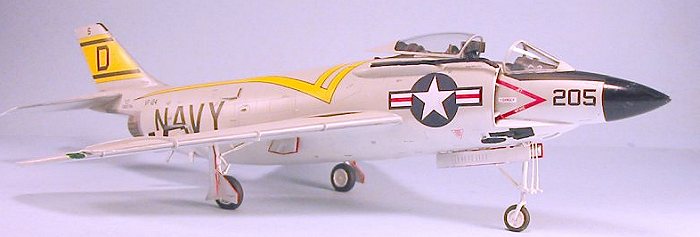
| KIT: | Grand Phoenix 1/48 F3H-2N Demon |
| KIT #: | 006 |
| PRICE: | $69.95 MSRP |
| DECALS: | Two options |
| REVIEWER: | Tom Cleaver |
| NOTES: | Multimedia kit with etched metal and resin parts |

| HISTORY |
On May 21, 1948, the United States Navy issued a "Request for Proposal" to build a carrier-based jet day fighter. The Navy wanted an aircraft of equal or superior performance to the land-based jet fighters being built at that time. The jet engine the Navy chose to power this aircraft was the Westinghouse afterburner-equipped J40 turbojet which was expected to provide twice the thrust of any engine then in Navy service. Eleven companies responded to the RFP and competed for the contract.
The response of the McDonnell Aircraft Corporation of St. Louis - builder of two of the Navy’s first three operational jet fighters, the FH-1 “Phantom” and F2H “Banshee” - was the F3H “Demon,” the first swept-wing jet fighter and the only single-engine carrier-based fighter built by the company. The proposal was chosen by the Navy in January 1949. That July, the Navy inspected a mockup of the XF3H-1 which resulted in some redesign to lower the predicted gross weight and two XF3H-1 prototypes were ordered on September 30, 1949. After the prototypes entered construction, the Navy decided it wanted the production aircraft to be an all-weather fighter, designated the F3H-1N. The mockup was modified to incorporate the changes directed by the Navy and was inspected again in July, 1951. The design changes resulted in a major delay in the program, although the XF3H-1 prototypes were not affected since they were to be used to conduct aerodynamic tests. The XF3H-1 prototype made its first flight on August 7, 1951.
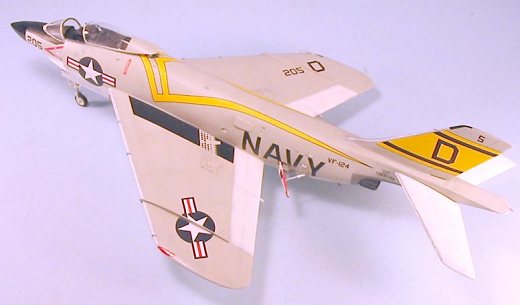 The appearance
of the MiG-15 in Korea resulted in a hasty order to put the F3H-1N in
production despite the fact the XF3H-1 had yet make its first flight. To
speed production, the Navy awarded a contract to the Temco Aircraft Corp.
for 100 Demons under license from McDonnell. This ill-conceived, hasty
decision was to have disastrous results.
The appearance
of the MiG-15 in Korea resulted in a hasty order to put the F3H-1N in
production despite the fact the XF3H-1 had yet make its first flight. To
speed production, the Navy awarded a contract to the Temco Aircraft Corp.
for 100 Demons under license from McDonnell. This ill-conceived, hasty
decision was to have disastrous results.
The afterburner-equipped version of the Westinghouse J40-WE-8 was not available to install in the prototypes at this time, so the non-afterburner J40-WE-6 was installed in its place. Many problems plagued the testing program. The J40 proved unreliable and the first prototype was damaged during a dead-stick landing caused by engine failure in August 1952; shortly th4ereafter, both prototypes were grounded because of engine problems. Other problems revealed during testing included poor forward visibility, slow roll rate, and poor lateral stability. The nose section was redesigned to deal with the visibility problem and the ailerons were moved further inboard to solve the roll rate problem, while wing fences were fitted on the outboard wing panel to improve lateral stability. A 10,500 lb. static thrust afterburning J40-WE-8 was installed in the second prototype in January 1953; the engine was no more reliable than the WE-6.
Preliminary flight evaluation at the Naval Air Test Center Patuxent, Maryland were conducted in August 1953. In October the second XF3H-1 was used for initial carrier landing evaluation flights aboard USS “Coral Sea” (CVA-43). The first prototype crashed after the engine exploded on March 18, 1954, which resulted in the second prototype being grounded; eventually it was shipped to the Naval Air Development Center at Johnsville, Pennsylvania, where it was used for barricade engagement tests.
The F3H-1N differed from the prototype by having the ailerons moved inboard to mid-trailing edge, while the radome and cockpit where angled down five degrees to alleviate the forward visibility problem during carrier landings. The main fuel tank size was increased by 378 gallons. The APG-30 radar and four 20mm cannon were installed. Mounting the 20mm cannon just below the air intakes would cause significant problems later.
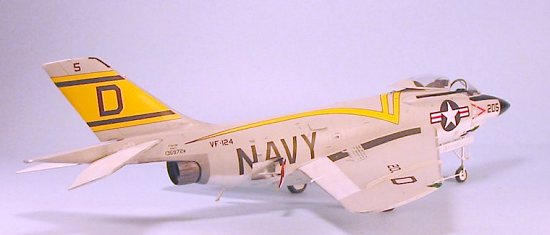 The first
production F3H-1N, BuNo. 133489, first flew on December 24, 1953. The
F3H-1N was initially powered by the J40-WE-8 turbojet engine with the
J40-WE-22 planned for installation in the production aircraft. The Navy
knew that the aircraft was grossly underpowered with this engine and
planned to replace it with J40-WE-24. By September 1953, the Navy
realized Westinghouse was not going to produce the WE-24 and that they
were stuck with the WE-22.
The first
production F3H-1N, BuNo. 133489, first flew on December 24, 1953. The
F3H-1N was initially powered by the J40-WE-8 turbojet engine with the
J40-WE-22 planned for installation in the production aircraft. The Navy
knew that the aircraft was grossly underpowered with this engine and
planned to replace it with J40-WE-24. By September 1953, the Navy
realized Westinghouse was not going to produce the WE-24 and that they
were stuck with the WE-22.
Late delivery of J40-WE-22 engines slowed the F3H-1N production line to a crawl. Eleven accidents, some fatal, over several days got the attention of the press, which complained loudly about how the Navy was spending a lot of money to acquire an aircraft whose greatest accomplishment seemed to be killing its own pilots. The F3H-1N was a dangerous aircraft to fly and was hated by its pilots. In the face of this, the F3H-1N set an unofficial time-to-climb to record of climbing to 10,000 feet in 71 seconds.
By 1952 McDonnell, fearing that the grossly underpowered J40 engine might
be the stake through the heart of the F3H Demon program, asked for and
received permission from an initially reluctant Bureau of Aeronautics to
consider other powerplants. BuAer hesitated at first because the J40 had
been designated as the powerplant in almost all the aircraft programs
currently in development; McDonnell was authorized to conduct a feasibility
study of fitting the F3H with the Allison J71 afterburning turbojet.
Finally facing the fact that there was no way to solve the
J40 problems, the Navy halted production of the F3H-1N after the 58th
aircraft and canceled Temco's contract before a single aircraft was built.
In July 1955 all F3H-1Ns were grounded and the Navy had to face growing
congressional upset over the $200 million expended on the F3H-1N and its
ill-fated engine. 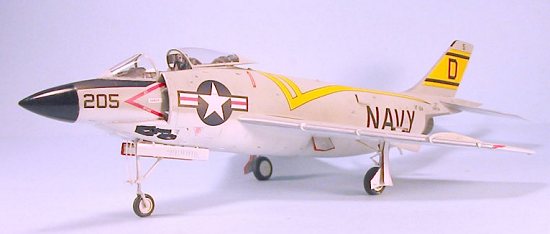 Worse
was the humiliation of barging F3H-1Ns from St. Louis to Memphis, where
they were towed to the Naval Air Station for maintenance training, while
F3H-1Ns at Patuxent River were sent to Norfolk for the same purpose.
Worse
was the humiliation of barging F3H-1Ns from St. Louis to Memphis, where
they were towed to the Naval Air Station for maintenance training, while
F3H-1Ns at Patuxent River were sent to Norfolk for the same purpose.
The failure of the J40 forced Westinghouse to close its jet engine manufacturing division. The future of McDonnell looked grim but the company survived by building the F3H-2 Demon, fitted with the Allison J71 engine. This version was designated the F3H-2N. In August 1953 BuAer inspected a mockup and in November 1953 amended the contract to fit the 32nd and 34th F3H-1N aircraft with Allison J71 prototypes. A following amendment called for the 61st and all subsequent Demons to be fitted with the J71.
The J71 was heavier than the J40; this increased weight plus the increase from making the Demon an all-weather fighter forced changes in the airframe, with wing area increased by 77 square feet by lengthening the wing chord by 40 inches at the root, moving the trailing edge back.
On April 23, 1955, the first F3H-2N prototype, BuNo 133520 flew at Lambert Field and the first production F3H-2N flew in June of 1955. McDonnell delivered 140 production F3H aircraft powered by the Allison J71-A2. The A2 engine provided 10,000 lbs. of thrust at full military power and 14,400 lbs. in afterburner. The A-2 was later replaced by A-2A or A-2B versions of the engine. The airframe was a good design that provided excellent maneuverability in air combat situations at altitude; many involved in the program thought the airplane would have been completely successful had it been powered by the superb J57 with afterburner, which would have provided an additional 2,500 pounds of thrust in afterburner without the weight penalty of the J71, and made the Demon fully supersonic rather than barely transonic.
 The last F3H-2
Demon was delivered on April 8, 1960. The total number of production
aircraft built and delivered was 519.
The last F3H-2
Demon was delivered on April 8, 1960. The total number of production
aircraft built and delivered was 519.
During its service, the Demon was largely unloved by its pilots. The fact it was underpowered in takeoff and landing configuration - the two most dangerous points of carrier-based operations - and did not have a zero-zero-ejection seat meant the pilots took off and landed with the canopy open in order to maximize their chance of survival in a crash. Several aircraft were lost when flown into icing conditions, which led to shutdown of the engine when ice was ingested. As a result, the Demon was prohibited from flying into known icing conditions, a serious restriction for an airplane that was supposed to be an all-weather interceptor.
On March 7, 1956, VF-14 “Tophatters” at NAS Cecil Field Florida received the first operational F3H-2Ns and flew the aircraft from USS Forrestal (CVA-59) during a Mediterranean deployment in January to July 1957. On September 2 1956, the second-day of the National Air Show, Lt(jg) Richard Carson, flying an F3H-2N Demon of VF-124, captured the McDonnell Trophy with a nonstop, non-refueled flight from the carrier U.S.S. “Shangri-la” cruising off San Francisco to Oklahoma City. He covered the 1,436 miles in 2 hours, 32 minutes, 13.45 seconds, for an average speed of 566.007 m.p.h.
22 squadrons were eventually equipped with the Demon, and it was flown in combat situations over Lebanon in the summer of 1958 and over the Formosa Straits during the Quemoy-Matsu crisis later that year. The last squadron equipped with the Demon was VF-161 at NAS Miramar, California. CO CDR Wayne Welty flew the last Demon from Miramar to NAF Litchfield Park on September 21, 1964.
| THE KIT |
Please visit the preview for a look at what comes in the box.
| CONSTRUCTION |
I have to say up front that, given my experience with the Grand Phoenix FJ-4 Fury last year, I was not one of those who shouted “Oh Joy!” when I heard the announcement earlier this year that the company’s next release would be the Demon. So, let me say right here at the outset that my fears were not borne out in experience. This kit of the F3H Demon exhibits none of the design or production problems of the earlier kit.
I started by assembling the wings and tail surfaces. I sanded these down before gluing them together, to give thinner trailing edges. The resin wheel wells fit without problem when I sanded them down to the point I could see light through the resin roof when I held the part up.
 Looking at the strange assembly of the fuselage, I decided to assemble the
fuselage in complete halves first, which would allow me to work on the
joints of the forward and main fuselage from inside and out, and to attach
any reinforcement necessary on the inside. As it turned out this was a
good idea, because I used Evergreen .010 sheet on the interior of the
joints to give added strength. After test fitting the fuselage halves, I
also made a second bulkhead just like the one provided in the kit, which I
attached just forward of where the wing spar goes; the spar was glued to
this before the fuselage halves were assembled. I had assembled the resin
afterburner and when this was test-fitted I decided it would be a good idea
to make a third bulkhead that would be
Looking at the strange assembly of the fuselage, I decided to assemble the
fuselage in complete halves first, which would allow me to work on the
joints of the forward and main fuselage from inside and out, and to attach
any reinforcement necessary on the inside. As it turned out this was a
good idea, because I used Evergreen .010 sheet on the interior of the
joints to give added strength. After test fitting the fuselage halves, I
also made a second bulkhead just like the one provided in the kit, which I
attached just forward of where the wing spar goes; the spar was glued to
this before the fuselage halves were assembled. I had assembled the resin
afterburner and when this was test-fitted I decided it would be a good idea
to make a third bulkhead that would be
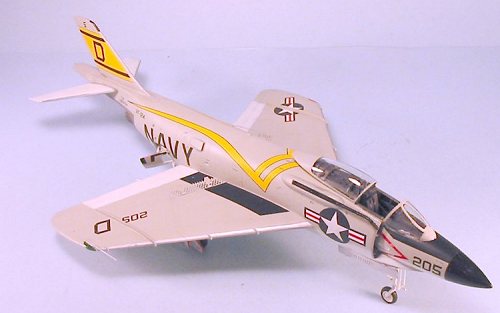 positioned so the
afterburner could be glued to it when installed. With these three
bulkheads installed, the large fuselage went together with only slight seam
problems which were easily solved with Mr. Surfacer 500.
positioned so the
afterburner could be glued to it when installed. With these three
bulkheads installed, the large fuselage went together with only slight seam
problems which were easily solved with Mr. Surfacer 500.
The resin cockpit went together with little problem, other than time taken to dremel off the casting block for it and the nose wheel well. I painted and detailed the cockpit and installed it, with only a bit of trimming necessary to get all the parts to fit well. I left the seat and control stick out till after the model was painted. I also added sufficient fish weights inside the radome to ensure the model would not be a tail-sitter, since it sits in a tail-low position.
The wings and tail surfaces went on without difficulty. Do be careful to align the tail boom correctly before installing these parts, and glue the exhaust shield in place only after you have the tail boom aligned right. Remember, this is a limited-run kit. This was the only problematic area I found.
 I also replaced the various photo-etch wing fences with fences made from
.010 Evergreen sheet, because the p-e parts looked to be nothing but
trouble down the line, being too thin to not be overly delicate when
handled. The resulting fences were a bit thicker than scale, but they are
solid and unlikely to present trouble in the future.
I also replaced the various photo-etch wing fences with fences made from
.010 Evergreen sheet, because the p-e parts looked to be nothing but
trouble down the line, being too thin to not be overly delicate when
handled. The resulting fences were a bit thicker than scale, but they are
solid and unlikely to present trouble in the future.
With the seams all sanded down and the panel lines rescribed where necessary, the model was ready to go to the paint shop after a surprisingly-easy build.
I did install the gear legs before painting, so the model could rest clear of the workbench while the paint was drying.
| COLORS & MARKINGS |
Painting:
 I pre-shaded the model with flat black, masked off the radome, then painted
the lower surfaces with Gunze-Sangyo H-316 “gloss white,” and did the upper
surfaces with Xtracrylix “Light Gull Grey,” a very nice new paint that
dries quickly and hard in semi-gloss. I hand-painted the leading edges of
the wings and tail with Model Master Aluminum to simulate the coroguard
paint.
I pre-shaded the model with flat black, masked off the radome, then painted
the lower surfaces with Gunze-Sangyo H-316 “gloss white,” and did the upper
surfaces with Xtracrylix “Light Gull Grey,” a very nice new paint that
dries quickly and hard in semi-gloss. I hand-painted the leading edges of
the wings and tail with Model Master Aluminum to simulate the coroguard
paint.
I then masked off the rear area and painted it with ModelMaster Magnesium and Stainless Steel. When that was dry I gave the model two coats of Future and we were ready for decals.
Decals:
 Scott had
let me know he was going to do the VF-122 airplane, so I did the VF-124
airplane, which I liked better anyway. VF-124 was the squadron with the
record-breaker in 1956, and was also involved in the Quemoy-Matsu crisis in
1958. The decals are Cartograf and went down with no trouble. When
everything was set up, I gave the model another coat of Future.
Scott had
let me know he was going to do the VF-122 airplane, so I did the VF-124
airplane, which I liked better anyway. VF-124 was the squadron with the
record-breaker in 1956, and was also involved in the Quemoy-Matsu crisis in
1958. The decals are Cartograf and went down with no trouble. When
everything was set up, I gave the model another coat of Future.
Final Finish:
I gave the white areas a coat of Glosscote, and the upper surfaces a couple coats of Dullcote.
I then installed the afterburner and then gave the area some exhaust staining with Tamiya “Smoke.” I then attached the horizontal stabilizers.
The seat went into the cockpit with no problem and the canopy was installed in the open position.
| CONCLUSIONS |
It’s a big, good-looking 1950s Navy jet, one of my favorite periods to do models of, and looks great sitting next to the F4D-1 Skyray and F-8J Crusader.
September 2004
Review kit courtesy of my wallet.
If you would like your product reviewed fairly and quickly by a site that has over 250,000 visitors a month, please contact me or see other details in the Note to Contributors.